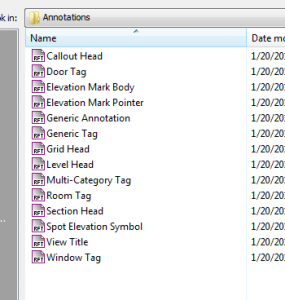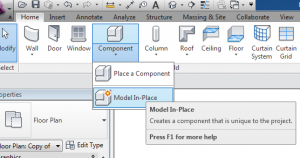In case you aren’t up on your abbreviations, that’s Red Headed Step Child, keeping in mind and continuing the whole family theme. Today is going to be yet another rather dry TotD that continues to prepare us novice Family creators on our journey into full family parenthood. So let’s delve further into family creation by examining the different types of families as well as some behaviors of the different categories.
So there’s three basic things you should get out of today’s TotD.
System Families
These are the immediate family members of your Revit project. They are always in the project no matter how hard you try to get rid of them, one will always be there. A good example of these families are your Assembly Families: Walls, Roofs, Floors, Ceilings, Stairs, Rails, Curtain Walls, etc. You can not delete all types of a System Family from a project! Kinda like an immediate family member >_>.
Some unexpected System Families you may not have thought of include Dimensions, Views, View Titles and Elevations!
User Families
These are the RFA files that you bring into a project. Much like your extended family, these are the hardest to stay in touch with, get used to and understand. These are the major customization components in Revit. Doors, Windows, Columns, Beams, Plumbing Fixtures, etc. More importantly your detail components, tags and many family types that are nested into system families like Mullion profiles for curtain walls, baluster families for rails and so on. You can start to see how these different family types begin to work with each other.
In-Place Families
Definitely the Red Headed Step Child of Revit families. I say this only because of the love/hate relationship that Revit users have for In-Place families. I know people that use In-Place families exclusively cause all of their projects are 100% one-off custom residential projects. I know some people that create an RFA for a 4″ section of Chair Molding that will only ever be used in one project simply because of their seething hatred for in-place families. Then there are those of us who preach against In-place families, (but then tell you to use them when you can with their tongue in their cheek while winking).
In-place families are well suited to one of situations that you really wouldn’t benefit from the parametric capabilities or mass use of a User Family. In-place families are also beneficial when you need to create custom families for system family categories, like walls and ceilings, to help better compatibility with other objects of the same category (think wild and crazy bulk head, wall category, but not that easy to model as an actual wall).
SO these are the basic building blocks of Revit. Simple right? See, nothing to this family editor stuff! Well, thanks again for stopping by and I look forward to having you again for another Revit TotD!
.Carl




One response to “Revit TotD – 5.12.2011 | Immediate, Extended and RHSC Families 2.1”
Added to my bookmarks =)